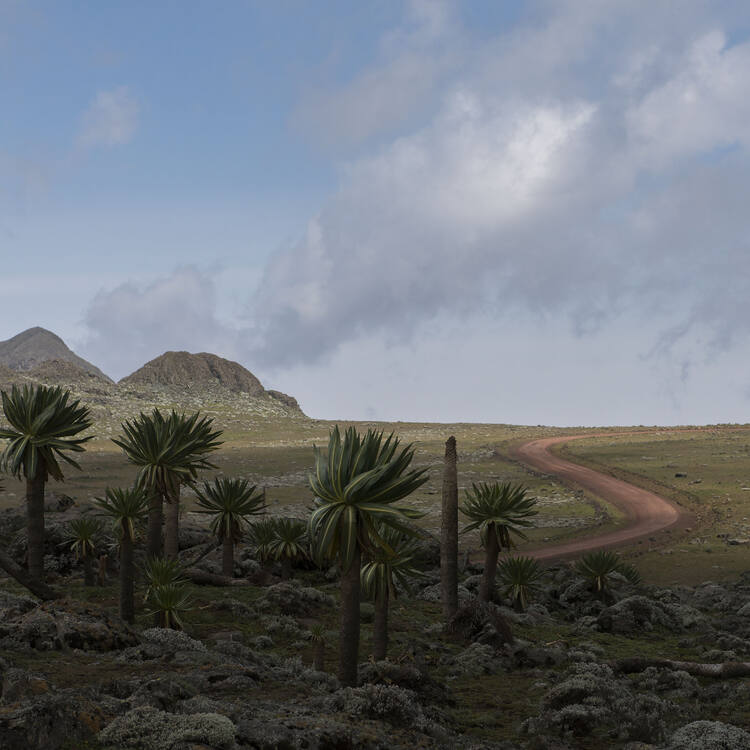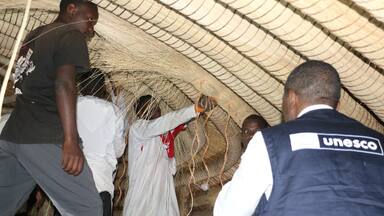Bale Mountains National Park
Bale Mountains National Park
Description is available under license CC-BY-SA IGO 3.0
Parc national des monts Balé
Description is available under license CC-BY-SA IGO 3.0
حديقة جبال بال الوطنية
source: UNESCO/CPE
Description is available under license CC-BY-SA IGO 3.0
巴莱山国家公园
source: UNESCO/CPE
Description is available under license CC-BY-SA IGO 3.0
Национальный парк Горы Бале
source: UNESCO/CPE
Description is available under license CC-BY-SA IGO 3.0
Parque Nacional de las Montañas de Bale
source: UNESCO/CPE
Description is available under license CC-BY-SA IGO 3.0
Outstanding Universal Value
Brief synthesis
Bale Mountains National Park (BMNP) boasts a spectacularly diverse landscape mosaic comprised of distinct ecosystems and habitats and associated biodiversity. The property covers an area of 215,000 hectares in the heart of the Bale-Arsi Massif in the south-eastern Ethiopian Highlands in Oromia National Regional State. Building upon much earlier efforts, the National Park has been legally protected and demarcated since 2014. The property includes the Africa’s largest area of afro-alpine habitat above 3,000 m above sea level (a.s.l.) with numerous glacial lakes, wetlands and moorlands. Volcanic ridges and peaks tower above the plateau, most prominently Tullu Dimtu, Ethiopia’s second highest peak at 4,377 m a.s.l. Elsewhere in the park, extensive grasslands thrive next to various types of forests including tree heath, bamboo and juniper forests. Significantly, the southern slopes of the Bale Mountains descend dramatically into the famous Harenna Forest, the second largest moist tropical forest in Ethiopia, including patches of cloud forest.
As the origin of several important rivers, the ecosystems and habitats within BMNP and its surroundings regulate the supply of water for millions of people in and beyond Ethiopia. The park and its surroundings are home to an extraordinary fauna and flora with an exceptional degree of endemism and in several cases the only remaining populations of globally threatened species across numerous taxonomic groups. For example, Mountain Nyala and Bale Monkey are both endemic to this area, along with numerous endemic rodents and amphibians, as well as the most important remaining population of Ethiopian Wolf. It is important to understand, however, that at the time of inscription, the property’s exceptional conservation values coincide with very high pressure on the ecosystems. Despite severe threats and a continuing need to better balance local livelihoods with the conservation of biodiversity and ecosystem services, longstanding conservation efforts, partnerships and the natural protection granted by the rugged terrain have maintained a favourable conservation status and outlook by the standards of the afro-alpine and East Africa’s moist tropical forests.
Criterion (vii): The property protects a landscape mosaic of extraordinary beauty that is shaped by the combined forces of ancient lava outpourings, glaciation and the dissection by the Great Rift Valley. It features volcanic peaks and ridges, dramatic escarpments, sweeping valleys, glacial lakes, lush forests, deep gorges and numerous waterfalls, creating an exceptional natural beauty. The altitudinal gradient of the park spans almost 2,900 metres from the highest peak standing at 4,377 m a.s.l. (Tullu Dimtu) down to approximately 1,500 m a.s.l. in the Harenna Forest. The altitudinal gradient not only creates vibrant changes in topography, soil, vegetation and species assemblages but constantly changing, breath-taking vistas. Amongst scattered wetlands and rocky outcrops, the iconic Giant Lobelias break the skyline above the otherwise stunted afro-alpine vegetation of the Sanetti Plateau, a harsh and aesthetically stunning high altitude environment. Unusual striations, or boulder grooves, mark the shallow hillsides, a natural phenomenon, which remains an enigma to geologists and glaciologists. Dropping from the plateau, the Harenna and the adjacent Mena Angetu form the second largest moist tropical forest in Ethiopia, transitioning in some areas into the country’s only remaining patches of cloud forest. This, combined with the plateaus, complete a unique, majestic landscape with an extraordinary natural aesthetic.
Criterion (x): The property harbours diverse and unique biodiversity at ecosystem, species and genetic levels. The Sanetti Plateau and the slopes of the Bale Mountains National Park above 3,500 m a.s.l. encompass the largest intact and contiguous expanse of afro-alpine habitat in the world further adding to the importance of the property as a rare large-scale remnant of this habitat. Uniquely, the afro-alpine of the Bale Mountains continues to be intricately linked to intact and large-scale expanses of forest, wetland and grassland ecosystems and habitats. More than 80% of all species found in the afro-montane habitat are endemic.
Bale Mountains National Park is home to 1,660 documented species of flowering plants, 177 of which are endemic to Ethiopia and 31 exclusively to the Bale Mountains. The forests of the Bale Mountains serve as a genetic reservoir for Wild Forest Coffee and countless medicinal plant species. 79 mammal species have been recorded in the park; 23 of these are endemic, including eight rodent species. There are 363 documented bird species, including over 170 recorded migratory bird species, such as wintering and passing raptors, including the Greater Spotted Eagle. While the afro-alpine habitats are not conspicuously rich in terms of plant species, more than 80 % of all species found in this type of habitat are endemic, an extreme degree of endemism by any standard. The afro-alpine has been recognized as a globally significant place in literally all major global conservation priority-setting exercises.
At the time of inscription, the Harenna Shrew, the Giant Mole Rat, the Malcolm’s Ethiopian Toad, the Bale Mountains Tree Frog and the Bale Mountains Frog can only be found in the Bale Mountains. The property hosts an estimated two-thirds of the global population of the endemic Mountain Nyala, the most important population of the endemic Ethiopian Wolf and it is home to the Menelik’s Bushbuck, an endemic subspecies. The Bale Monkey is endemic to the Ethiopia Highlands, east of the Rift Valley and is restricted to the bamboo belt of the Bale Mountains and the Sidamo Highlands.
Integrity
Covering 215,000 hectares, the property serves as a meaningful and viable representation of afro-alpine and associated forests. The afro-alpine Sanetti Plateau is situated within the property in its entirety. At the foot of the southern escarpment lies the tropical moist Harenna Forest, one of Ethiopia’s largest natural forests, granted protection in the national law with about 100,000 hectares within BMNP and the adjacent areas. The forest cover in the park is almost continuous with a low level of fragmentation and degradation. The dense, green, misty jungle contains huge trees, moss draped branches, and impenetrable undergrowth wrapped in a tangle of creepers among which wild coffee and medicinal plants grow. Unlike most of the wider ecoregion, the land and resources protected by the national park are still in a relatively good state of conservation due to the longstanding conservation efforts, the remote location and the rugged terrain.
Nevertheless, pressures on the property’s nature conservation values at the time of inscription are related to unsustainable practices linked to increasing human settlement within and around the park, including expansion of livestock grazing and agriculture. Although localized degradation has occurred, the full array of ecosystem and habitat diversity, hosting complete native species assemblages, continues to exist. Other threats to the integrity of BMNP requiring long-term attention include the existing road crossing the park’s vulnerable key habitats. The road generates some direct disturbance and facilitates access to otherwise remote areas.
The property, with its clear, legally defined boundary, is of sufficient size to protect a large, particularly valuable and still remarkably intact example of the linked ecosystems and habitat mosaic of this area. The property has a recognized buffer zone comprising all 29 neighbouring kebeles (the smallest administrative unit in Ethiopia) surrounding the legally gazetted and demarcated park boundary as a key investment in the future integrity of the property. The buffer zone itself harbours very important conservation values, as well as securing landscape connectivity beyond the property.
Protection and management requirements
Bale Mountains National Park is managed by the Ethiopian Wildlife Conservation Authority (EWCA). EWCA is a self-governed body, created by Proclamation No. 575/2008 of the Federal Democratic Republic of Ethiopia and regulated by National Law of Wildlife Development, Conservation and Utilization (Proclamation No. 541/2007). The entire surface area of the property of 215,000 hectares enjoys a high level of legal protection in line with IUCN Protected Area Category II. The national park is surrounded by an officially recognized buffer zone of 235,121 hectares, ranging between approximately 5 to 20 km from the boundaries of the park. The Oromia National Regional State acting through the local woreda (district authorities) and kebele committees are critically important partners in the management of the property and its buffer zone. Regulation 338/2014 includes the establishment of a statutory Park Advisory Committee (PAC) with representation of the park adjacent woredas. In each woreda, a Park Community Dialogue Forum (PCDF) has been established with representation from each of the park adjacent kebele. The PAC reports to the Bale Regional-Federal Coordination Committee which provides the policy direction with regard to addressing threats to the park.
In the buffer zone, Oromia National Regional State, the local government bodies and Oromia Forest and Wildlife Enterprise (OFWE) support more integrated and landscape scale governance of the Bale eco-region through Participatory Forest Management (PFM) cooperatives, Community Conservancies (CC) and Controlled Hunting Areas (CHA) linking to the park through bodies such as the PCDF. The Governance of the buffer zone promotes sustainable natural resource use by the park adjacent communities without compromising conservation and the ecosystem services of the property.
Managed by EWCA, the park has its own park administration office with additional ranger outposts and mobile camps. Park staff includes around 80 rangers at the time of inscription. The property’s strategic and operational management is guided by a 10-year General Management Plans (GMP), which includes management programmes on Park Operations; Tourism Management; Interim Settlement & Grazing Management; Outreach and Ecological Management. In addition, a Tourism Development Plan guides the management actions to improve community benefits from tourism whilst managing the impact of visitors on the property. Threats to the property are actively being addressed through the General Management Plan’s Interim Settlement Grazing Management Programme, a Grazing Pressure Reduction Strategy and a linked Livelihood Improvement Strategy, which include measures to reduce livestock to sustainable levels and gradually expand no-grazing zones through a participatory process with relevant communities. Strict adherence to a rights-based approach and to the principle of free, prior and informed consent of the affected communities are key requirements for the management of the property.
One challenge beyond the scope of EWCA and park management has been sporadic civil unrest but the situation is improving. Nonetheless, there is progress in terms of enhancing communication and collaboration with all stakeholders and rights-holders, a crucial long-term task. Efforts are underway to improve the critically important dialogue and cooperation with local communities, resource users and all levels of government. Mechanisms are emerging to more effectively incorporate park protection into local development strategies with an emphasis on addressing the issues of settlement and livestock grazing in the park, while fully taking into account local needs.

